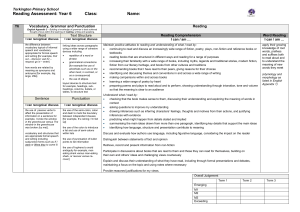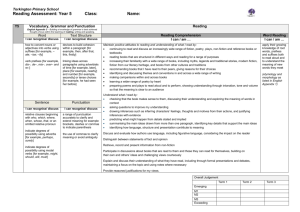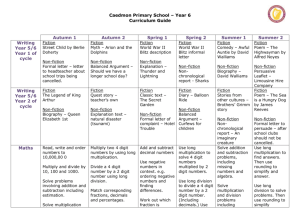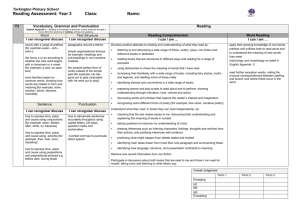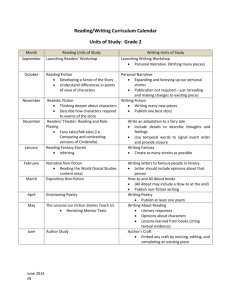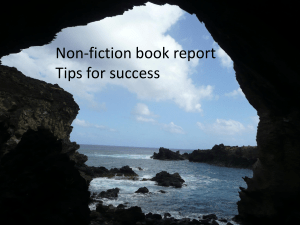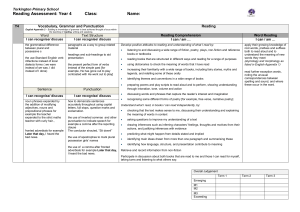Caedmon Primary School – Year 4 Curriculum Guide Autumn 1
advertisement
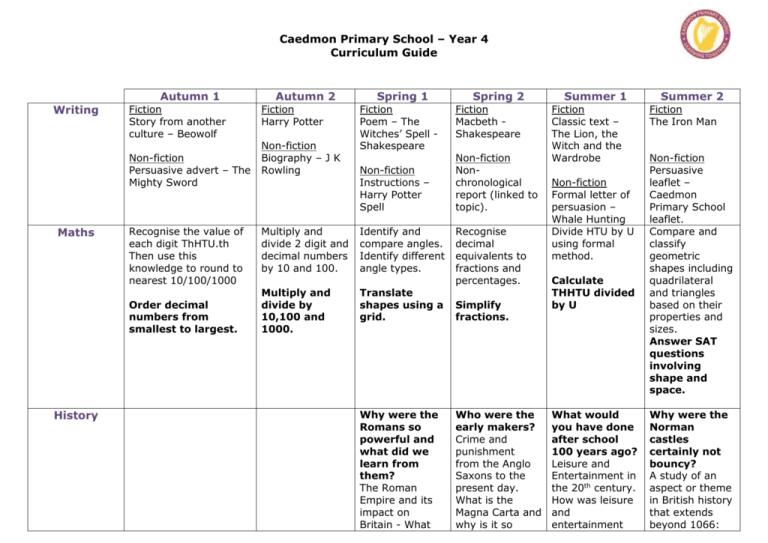
Caedmon Primary School – Year 4 Curriculum Guide Autumn 1 Writing Fiction Story from another culture – Beowolf Non-fiction Persuasive advert – The Mighty Sword Maths Recognise the value of each digit ThHTU.th Then use this knowledge to round to nearest 10/100/1000 Order decimal numbers from smallest to largest. History Autumn 2 Fiction Harry Potter Non-fiction Biography – J K Rowling Multiply and divide 2 digit and decimal numbers by 10 and 100. Multiply and divide by 10,100 and 1000. Spring 1 Fiction Poem – The Witches’ Spell Shakespeare Non-fiction Instructions – Harry Potter Spell Identify and compare angles. Identify different angle types. Translate shapes using a grid. Why were the Romans so powerful and what did we learn from them? The Roman Empire and its impact on Britain - What Spring 2 Fiction Macbeth Shakespeare Non-fiction Nonchronological report (linked to topic). Recognise decimal equivalents to fractions and percentages. Simplify fractions. Who were the early makers? Crime and punishment from the Anglo Saxons to the present day. What is the Magna Carta and why is it so Summer 1 Fiction Classic text – The Lion, the Witch and the Wardrobe Non-fiction Formal letter of persuasion – Whale Hunting Divide HTU by U using formal method. Calculate THHTU divided by U What would you have done after school 100 years ago? Leisure and Entertainment in the 20th century. How was leisure and entertainment Summer 2 Fiction The Iron Man Non-fiction Persuasive leaflet – Caedmon Primary School leaflet. Compare and classify geometric shapes including quadrilateral and triangles based on their properties and sizes. Answer SAT questions involving shape and space. Why were the Norman castles certainly not bouncy? A study of an aspect or theme in British history that extends beyond 1066: Caedmon Primary School – Year 4 Curriculum Guide Geography Why is the Tyne so important to Newcastle? Settlements, land use, economic activity including natural resources especially energy and water supplies Science How would we survive without water? Compare and group materials together, according to whether they are solids, liquids or gases. Observe that some materials change state Why is Newcastle such a cool place to live? Name and locate counties and cities of the United Kingdom, geographical regions and their identifying human and physical characteristics; understand how some of these aspects have changed over time. Which wild animals and plants thrive in your locality? Identify and name a variety of living things (plants and animals) in the local and wider did the Romans do for us? - Who were the famous Romans and what do we know about them? important even today? different for rich and poor children 100 years ago? The Norman invasion and its impact on British society. Why is the sound that ‘One Direction’ makes enjoyed by so many? Identify how sounds are made, associating some of them How could we cope without electricity for one day? Identify common appliances that run on electricity. Construct a simple series Assessment What happens to the food we eat? Describe the simple functions of the basic parts of the digestive system in humans. Identify the Caedmon Primary School – Year 4 Curriculum Guide Computing when they are heated or cooled, and measure or research the temperature at which this happens in degrees Celsius (°C). Identify the part played by evaporation and condensation in the water cycle and associate the rate of evaporation with temperature. environment, using classification keys to assign them to groups. Recognise that environments can change and that this can sometimes pose dangers to living things. with something vibrating. Find patterns between the pitch of a sound and features of the object that produced it. Find patterns between the volume of a sound and the strength of the vibrations that produced it. electrical circuit, identifying and naming its basic parts, including cells, wires, bulbs, switches and buzzers. Identify whether or not a lamp will light in a simple series circuit, based on whether or not the lamp is part of a complete loop with a battery. Recognise that a switch opens and closes a circuit and associate this with whether or not a lamp lights in a simple series circuit. Recognise some common conductors and insulators, and associate metals with being good conductors. E-Safety use technology Computer Science Digital Literacy Presentation Digital Literacy Desktop different types of teeth in humans and their simple functions. Construct and interpret a variety of food chains, identifying producers, predators and prey. Digital Literacy Web Research Digital Literacy Class Comic Caedmon Primary School – Year 4 Curriculum Guide safely, respectfully and responsibly; recognise acceptable/unaccept able behaviour; identify a range of ways to report concerns about content and contact Quiz Scratch Publishing Publisher Internet Explorer Computer Science Conversation Scratch Media PowerPoint design, write and debug programs that accomplish specific goals, including controlling or simulating physical systems; solve problems by decomposing them into smaller parts use sequence, selection, and repetition in programs; work with variables and various forms of input and output use logical reasoning to explain how some simple algorithms work and to detect design, write and debug programs that accomplish specific goals, including controlling or simulating physical systems; solve problems by decomposing them into smaller parts use sequence, selection, and repetition in programs; work with variables and various forms of input and output use logical reasoning to explain how some simple algorithms work and to detect and correct errors in algorithms select, use and combine a variety of software (including internet services) on a range of digital devices to design and create a range of programs, systems and content that accomplish given goals, including collecting, analysing, evaluating and presenting data and information select, use and combine a variety of software (including internet services) on a range of digital devices to design and create a range of programs, systems and content that accomplish given goals, including collecting, analysing, evaluating and presenting data and information understand computer networks, including the internet; how they can provide multiple services, such as the World Wide Web, and the opportunities they offer for communicatio n and collaboration Comic Life select, use and combine a variety of software (including internet services) on a range of digital devices to design and create a range of programs, systems and content that accomplish given goals, including collecting, analysing, evaluating and presenting data and information Caedmon Primary School – Year 4 Curriculum Guide and correct errors in algorithms and programs P.E. P.S.H.E. French and programs Invasion Games LO: Receiving & Self Belief Dance LO: Turning and Suggest Improvements Gymnastics LO: Stopping and Co-operate Gymnastics LO: Selfevaluate & listen to others Athletics LO: Running and take turns Striking and Fielding LO: Throwing and catching Children’s Rights, Responsibilities and Risks Continue to use the vocabulary learnt in year 3, and learn a small amount of new vocabulary including nouns, verbs, adjectives and a conjunction. They learn to use sentence starters (in the form of simple adverbial phrases of place), e.g. Dans le sac, Chez moi. They learn to recognise and use plural forms of nouns, and to apply adjectival agreement by gender and number. Recognise certain phonemes when they hear them, and identify the Anti-Bullying Third World Conflict Equality Fait Trade Compare pronunciation at word and sentence level by learning about the concepts of liaison and elision, knowing that the final consonant of a word is almost always silent at word level and that the final consonant in the word et is always silent. Create simple and sometimes more complex Memorise and recite a bank of finger rhymes Listen to stories and become familiar with stories known and loved by French children Learn about customs and celebrations in France and make comparisons with customs and celebrations in their own culture Listen to and sing along with traditional French folk songs Listen to and sing along with songs by the popular singer Henri Dès Become familiar with the works of the painters Degas, Cézanne and Matisse and the music of the composer Ravel Become familiar with the region of the Dordogne in France by regularly looking at photographs on PowerPoint slides, and using webcams to make virtual visits Caedmon Primary School – Year 4 Curriculum Guide graphemes that can be used to represent them Music Art Whole-Class Recorder Hot and cold colours Name the colours they use including shades. Use thick and thin brushes Name the primary and secondary colours. spoken and written sentences, e.g. Dans le sac il y a un chat rouge et un chien bleu. Dans le sac il y a trois petits chats verts et une grande baleine bleue. Whole-Class Recorder Whole-Class Recorder Whole-Class Recorder Roman Weapons D&T Building a Roman Catapult R.E. How and why do Hindus celebrate Divali? Why is Lent such an important time for Christians? To understand the basic facts of the Hindu To understand why Lent is Whole-Class Recorder Whole-Class Recorder Entertainment and Leisure 100 years ago Make your own board game What can we learn about symbols and beliefs from visiting religious buildings? Caedmon Primary School – Year 4 Curriculum Guide religion. To understand the key events of the story of Rama and Sita. To understand the characters’ feelings in the story. To understand the key events of the story of Rama and Sita. To understand the characters’ feelings in the story. important to Christians. To understand that the value placed on objects and experience varies, that what people regard as precious reveals their underlying values and links to how they live their lives. To be able to classify different types of religious buildings and objects . To understand that beliefs, ideas and feelings can be expressed in a variety of ways. To be able to describe what sorts of things are found in religious buildings.
